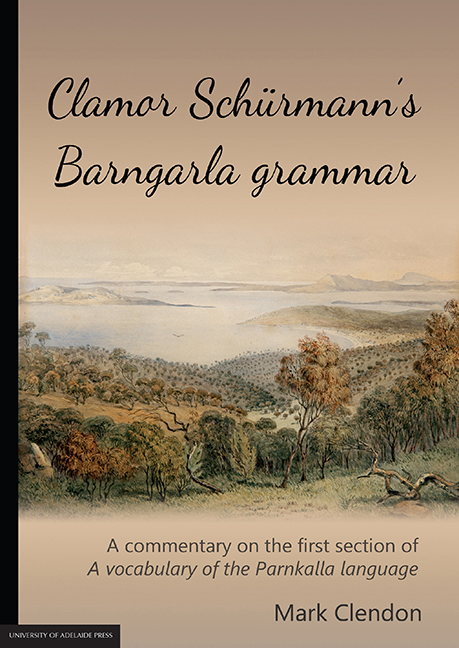 Clamor Schürmann's Barngarla grammar
Clamor Schürmann's Barngarla grammar Book contents
- Frontmatter
- Frontispiece
- Contents
- Abbreviations used in glossing sentence examples & in the text
- Preface
- Map: The northern and western Thura-Yura languages
- 1 Introduction
- 2 Writing Barngarla sounds
- 3 Pronouns
- 4 Intransitive verbs
- 5 Transitive verbs
- 6 Harry Crawford's Barngarla verbs
- 7 Suffixes on nouns
- 8 Other suffixes
- 9 Demonstrative & interrogative pronouns
- 10 Verbal derivational affixes
- 11 Non-finite verbs
- 12 Putting words together
- 13 Prospect
- Appendix The name Barngarla
- References
5 - Transitive verbs
Published online by Cambridge University Press: 05 February 2016
- Frontmatter
- Frontispiece
- Contents
- Abbreviations used in glossing sentence examples & in the text
- Preface
- Map: The northern and western Thura-Yura languages
- 1 Introduction
- 2 Writing Barngarla sounds
- 3 Pronouns
- 4 Intransitive verbs
- 5 Transitive verbs
- 6 Harry Crawford's Barngarla verbs
- 7 Suffixes on nouns
- 8 Other suffixes
- 9 Demonstrative & interrogative pronouns
- 10 Verbal derivational affixes
- 11 Non-finite verbs
- 12 Putting words together
- 13 Prospect
- Appendix The name Barngarla
- References
Summary
Transitive verbs are those that need an object — typically verbs such as hitting: you need to hit something, to see something, to hear something, to catch something, and so on. Despite that, in English lots of verbs can be both intransitive and transitive: for example, you can eat chips (with an object), or you can just be eating (with no stated object).
With transitive verbs in Barngarla, you need to use the ergative shapes of nouns, or the singular ergative pronouns ngadhu ‘I’, nhurnu ‘you’ or badlu ‘he, she’ with, or in front of the verb.
Schürmann uses a verb that I will transcribe as widi- ‘spear, pierce’ to illustrate how transitive verbs work in Barngarla. Kuyani has wityi- ‘to spear’ (Hercus 2006a) and Wirangu has widyirn ‘throw a weapon’ (Miller et al. 2010: 86). Adnyamathanha has witi- ‘to spear’ (McEntee & McKenzie 1992: 120), and also withi- ‘spear, stake’ (that is, impale with a stick into the ground) (McEntee & McKenzie 1992: 121). I will assume that the first Adnyamathanha verb corresponds most closely to the one that Schürmann uses to exemplify the conjugation of transitive verbs.
Present tense
Here are the long forms of the present/future tense of the verb widi-, showing the ending -dhi harmonising with the last vowel in the verb root.
Note that while the singular pronouns are marked for ergative case, the non-singular pronouns are the same as those used with the intransitive verb nguga-; that is, they do not display case-marking here:
Again, there are a few things we can note about these forms:
Note again the segment -ma- in the 2 dual and 3 dual subject shapes, and the ending -nha in the 2 pl and 3 pl subject shapes, again only in verbs that do not have pronoun suffixes attached.
The present-tense suffix, which is -dhi on most forms, goes to -dha when it comes in front of -(a)ru and -(a)nha, and also when it comes after -ma-.
Instead of the intransitive 3 sg subject ending -wo (-wu), Schürmann has a transitive 3 sg subject ending he spells -rru. The phonemic form of this ending needs some discussion (see Section 5.2 below).
Note that for the 3 dual pronoun Schürmann here has padlanbi: this is surely a typo, as this word is pudlanbi in every other transitive list.
- Type
- Chapter
- Information
- Clamor Schürmann's Barngarla grammarA commentary on the first section of A vocabulary of the Parnkalla language, pp. 55 - 66Publisher: The University of Adelaide PressPrint publication year: 2015


